Martin Landau archives
Space 1999 Locations
This is a guide to Pinewood Studios from Martin Landau's archive, given to him in 1973 when he first started working on Space: 1999. The booklet is 132mm x 216mm with 8 smaller interior pages (126mm x 202mm), with black and white photos and red headings.
The Rank Organisation was formed in 1937 by J Arthur Rank, millionaire son of a wealthy flour miller, shortly after he started developing Heatherden Hall into Pinewood Studios (opened in 1936). Rank owned large parts of the British film industry, including the Odeon cinema chain (acquired 1938, and later Gaumont and Paramount chains), Rank Film Distributors, Rank Screen Advertising, Rank Film Laboratories in Denham, and the Company of Youth acting school (students included Christopher Lee, Joan Collins and Patrick McGoohan). In 1956 it formed an alliance with American company Xerox to form Rank Xerox, introducing photo-copiers to Europe. It even owned many motorway service stations. The Rank Group sold their remaining film industries in the late 1990s and early 2000s, eventually being absorbed into Xerox.
Although Martin Landau was given this in 1973, the booklet seems to be from the late 1950s or early 1960s, based on the stars and films mentioned (the latest film released in 1956; the Bond films, which started in 1962, are not mentioned).

This booklet has been specially prepared by Pinewood Studios for its guests
Even a quiet country dawn has its surprises...
Along the narrow country road which leads nowhere special, a big black car glides. A grey dawn has barely broken. There is silence. The fields are sleepy. The trees are ruffled by a breeze. And no birds sing. It is too early.
Huddled into a corner of the back seat is a girl. Like the day, she is barely awake. But she is resigned. The car glides off to the left, through a gateway, along a concrete road. Outside a low building the car halts. The girl-she is a film star at her least public moment-hurries inside.
In a small room there are quick good mornings. Yawns. The film star sits before a mirror. It is just past dawn. But she is having her hair done.
Along the obscure country road that ambles through the Buckinghamshire countryside is a road sign. It could be outside a pub or a roadhouse. But under the figure of a man striking a gong it says: PINEWOOD STUDIOS. For along that concrete drive- way is the hub of the Rank Organisation- the studio in which are made the films that go round the world. Twenty-four miles along the concrete Westbound highway from London you turn off the mainstream to find Pinewood. It is deceptively rural. For here you find 100 acres of bustling, never-ending activity.
It is a stone's-throw from farms and scattered houses. But here are painters and carpenters, joiners and plasterers. Here are sculptors and electricians, writers and scientists, musicians and engineers. Here is all the complex business of film making.
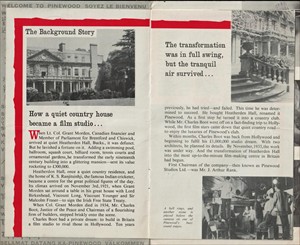
How a quiet country house became a film studio...
When Lt. Col. Grant Morden, Canadian financier and Member of Parliament for Brentford and Chiswick, arrived at quiet Heatherden Hall, Bucks., it was defunct. But he lavished a fortune on it. Adding a swimming pool, ballroom, squash court, billiard room, tennis courts and ornamental gardens, he transformed the early nineteenth century building into a glittering mansion-sent its value rocketing to £300,000.
Heatherdon Hall, once a quiet country residence, and the home of K. S. Ranjitsinhji, the famous Indian cricketer, became a centre for the great political figures of the day. Its climax arrived on November 3rd, 1921, when Grant Morden sat around a table in his great house with Lord Birkenhead, Viscount Long, Viscount Younger and Sir Malcolm Fraser-to sign the Irish Free State Treaty.
When Col. Grant Morden died in 1934, Mr. Charles Boot, Justice of the Peace and Chairman of a flourishing firm of builders, stepped briskly onto the scene.
Charles Boot had a private dream: to build in Britain a film studio to rival those in Hollywood. Ten years previously, he had tried- and failed. This time he was determined to succeed. He bought Heatherden Hall, renamed it Pinewood. As a first step he turned it into a country club. While Mr. Charles Boot went off on a fact-finding trip to Hollywood, the first film stars came down that quiet country road- to enjoy the luxuries of Pinewood's club.
Within months, Charles Boot was back from Hollywood and beginning to fulfil his £1,000,000 studio dream. With two architects, he planned its details. By November, 1935, the work was under way. And the transformation of Heatherden Hall into the most up-to-the-minute film-making centre in Britain had begun.
First Chairman of the company-then known as Pinewood Studios Ltd.-was Mr. J. Arthur Rank.
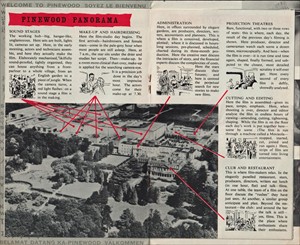
This is an old photo of the studio, with undeveloped land. It only indicates 4 stages (A-D; now there are 30). Stages L and M are beyond the top of the map and may not have been built at the time of this photo.
SOUND STAGES
The working hub-big, hangar-like, unglamorous. Here sets are built, lights lit, cameras set up. Here, in the early morning, actors and technicians assemble, and here they actually make the film. Elaborately mechanised, skilfully sound-proofed, tightly organised, they can house anything from a front- parlour to a whole village, from an English garden to a piece of jungle. When the camera turns, a red light flashes: on a sound stage a film is in the making.
MAKE-UP AND HAIRDRESSING
Here the film-studio day begins. The first arrivals-hairdressers and female stars come in the pale-grey hour when most people are still asleep. Here, at 7 a.m., the star sits under the drier and studies her script. Then-make-up. In a room more clinical than cosy, make-up is applied for the searching camera-eye. It is a precision job done in the day's most imprecise hour. The actors come for their make-up at 7.30.
ADMINISTRATION
Here, in offices surrounded by elegant gardens, are producers, directors, writers, accountants and planners. This is where a film is conceived, developed, plotted; where it is discussed in hours- long sessions, pre-planned, scheduled, charted during its three-month production. Here the creative men discuss the intricacies of story, and the financial experts discuss the complexities of costs. Here the stars discuss their futures; and here is centred the perpetual search for new stories to make new films.
PROJECTION THEATRES
Bare, functional, with two or three rows of seats: this is where, each day, the result of the previous day's filming is shown. Here producer, director and cameraman watch each scene a dozen times, microscopically. And here when the film is over-it is run time and time again, shaped, finally formed, and subjected to the closest, most detailed scrutiny it will ever get. Here every second of every film is deftly, shrewdly analysed.
CUTTING AND EDITING
Here the film is assembled-given its pace, tempo, emphasis. Here, when shooting is over, director and editor analyse the film in endless hours of viewing amending, cutting, tightening, shaping. While the film is on the floor each day's work is put together here- scene by scene. (The film is run through a machine called a Movieola- stopped, started, cut, joined and run again.) Here, strips of film are turned into living entertainment.
CLUB AND RESTAURANT
This is where film-makers relax. In the elegantly panelled restaurant, stars, producers, directors, writers eat lunch (in one hour, flat) and talk-films. At one table, the team of a film on the floor discuss the "rushes" they have just seen. At another, a similar group anticipate and plan. Beyond the restaurant-the club: and around the bar the talk is still- yes, films. This is the place where enthusiasts share their enthusiasms.
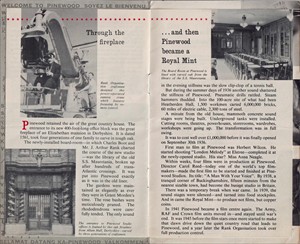
Pinewood retained the air of the great country house. The entrance to its new 400-foot-long office block was the great fireplace of an Elizabethan mansion in Derbyshire. It is dated 1561, took four generations of one family to carve in tough oak. The newly-installed board-room- in which Charles Boot and Mr. J. Arthur Rank charted the course of the new studio -was the library of the old S.S. Mauretania, broken up after hundreds of trans- Atlantic crossings. It was put into Pinewood exactly as it was in the old liner.
The gardens were maintained as elegantly as ever they were in Grant Morden's time. The rose bushes were meticulously pruned. The rhododendrons were care- fully tended. The only sound in the evening stillness was the slow clip-clop of a tennis ball.
But during the summer days of 1936 another sound shattered the stillness of Pinewood. Pneumatic drills rattled. Steam hammers thudded. Into the 100-acre site of what had been Heatherden Hall, 1,500 workmen carted 6,000,000 bricks, 60 miles of electric cable, 2,300 tons of steel.
A minute from the old house, mammoth concrete sound stages were being built. Underground tanks were installed. Cutting rooms, theatres, powerhouses, storerooms, wardrobes, workshops were going up. The transformation was in full swing. It was to cost well over £1,000,000 before it was finally opened on September 30th 1936.
First man to film at Pinewood was Herbert Wilcox. He started shooting "London Melody" at Elstree completed it at the newly-opened studio. His star? Miss Anna Neagle.
Within weeks, four films were in production at Pinewood. Director Carol Reed- today one of the world's top film- makers- made the first film to be started and finished at Pinewood Studios. Its title: "A Man With Your Voice". By 1938, a tranquil corner of Buckinghamshire, fifteen minutes from the nearest sizeable town, had become the busiest studio in Britain.
There was a temporary break when war came. In 1939, the sound stages were silenced-and turned into food stockpiles. And in came the Royal Mint-to produce not films, but copper coins.
In 1941 Pinewood became a film centre again. The Army, RAF and Crown film units moved in-and stayed until war's end. It was 1945 before the film stars once more started to make that dawn drive down the quiet country road that leads to Pinewood, and a year later the Rank Organisation took over full production control.
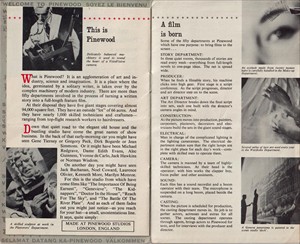
What is Pinewood? It is an agglomeration of art and industry, science and imagination. It is a place where the idea, germinated by a solitary writer, is taken over by the complex machinery of modern industry. There are more than fifty departments involved in the process of turning a written story into a full-length feature film.
At their disposal they have five giant stages covering almost 94,000 square feet. They have an outside "lot" of 66 acres. And they have nearly 1,000 skilled technicians and craftsmen- ranging from top-flight research workers to hairdressers.
Down that quiet road to the elegant old house and the bustling studio have come the great names of show business. In the back of that early-morning car you might have seen Gene Tierney or Gregory Peck, Dirk Bogarde or Jean Simmons. Or it might have been Michael Redgrave, Dame Edith Evans, Alec Guinness, Yvonne de Carlo, Jack Hawkins or Norman Wisdom.
On another day you might have seen Jack Buchanan, Noel Coward, Laurence Olivier, Kenneth More, Marilyn Monroe.
For this is the studio from which have come films like "The Importance Of Being Earnest", "Genevieve", "The Kid- nappers", "Doctor In the House", "Reach For The Sky", and "The Battle Of The River Plate". And as each of them fades out you might just notice-as you reach for your hat-a small, unostentatious line. It says, quite simply:
MADE AT PINEWOOD STUDIOS
LONDON, ENGLANDA Film is Born
Some of the fifty departments at Pinewood which have one purpose: to bring films to the screen...
STORY DEPARTMENT:
In three quiet rooms, thousands of stories are read every week-everything from full-length novels to one-page ideas. The net is spread wide.
PRODUCER:
When he finds a filmable story, his machine clicks into high gear. First stage is a script conference. As the script progresses, director and art director step on to the scene.
ART DEPARTMENT:
The Art Director breaks down the final script into sets, each one built with the director's camera angles in mind.
CONSTRUCTION:
As the picture moves into production, painters, carpenters, plasterers, decorators and electricians build the sets in the giant sound stages.
ELECTRICAL:
Man in charge of the complicated lighting is the lighting cameraman. The electrical department makes sure that the right lamps are in the right place for each day's work- complete with skilled men to operate them.
CAMERA:
The camera is manned by a team of highly- skilled technicians. At their head is the operator; with him works the clapper boy, focus puller and other assistants.
SOUND:
Each film has a sound recordist and a boom operator with their team. The microphone is suspended on a long boom, placed beside the camera.
CASTING:
When the picture is scheduled for production, the casting department moves in. Its job is to gather actors, actresses and extras for all scenes. The casting department operates through agents, brings actors to Pinewood for tests, and for interviews with the producer and director.
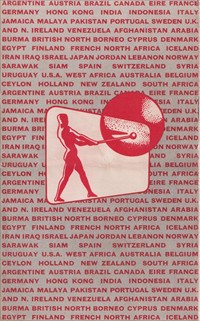
Contents copyright Martin Willey